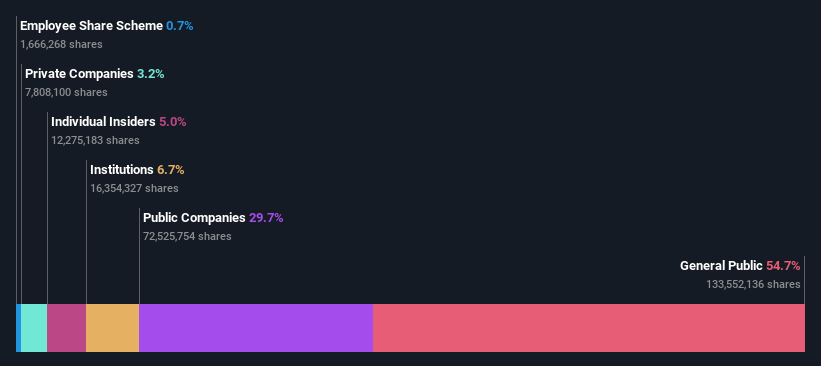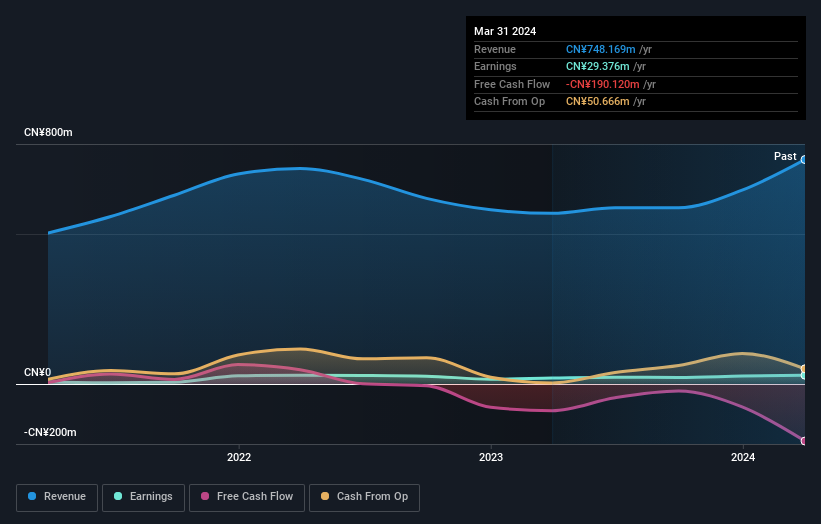- China
- /
- Electronic Equipment and Components
- /
- SZSE:002134
Retail investors are Tianjin Printronics Circuit Corporation's (SZSE:002134) biggest owners and were rewarded after market cap rose by CN¥217m last week

Key Insights
- Tianjin Printronics Circuit's significant retail investors ownership suggests that the key decisions are influenced by shareholders from the larger public
- The top 20 shareholders own 45% of the company
- Past performance of a company along with ownership data serve to give a strong idea about prospects for a business
Every investor in Tianjin Printronics Circuit Corporation (SZSE:002134) should be aware of the most powerful shareholder groups. With 55% stake, retail investors possess the maximum shares in the company. That is, the group stands to benefit the most if the stock rises (or lose the most if there is a downturn).
Clearly, retail investors benefitted the most after the company's market cap rose by CN¥217m last week.
In the chart below, we zoom in on the different ownership groups of Tianjin Printronics Circuit.
Check out our latest analysis for Tianjin Printronics Circuit

What Does The Institutional Ownership Tell Us About Tianjin Printronics Circuit?
Many institutions measure their performance against an index that approximates the local market. So they usually pay more attention to companies that are included in major indices.
We can see that Tianjin Printronics Circuit does have institutional investors; and they hold a good portion of the company's stock. This can indicate that the company has a certain degree of credibility in the investment community. However, it is best to be wary of relying on the supposed validation that comes with institutional investors. They too, get it wrong sometimes. When multiple institutions own a stock, there's always a risk that they are in a 'crowded trade'. When such a trade goes wrong, multiple parties may compete to sell stock fast. This risk is higher in a company without a history of growth. You can see Tianjin Printronics Circuit's historic earnings and revenue below, but keep in mind there's always more to the story.

Hedge funds don't have many shares in Tianjin Printronics Circuit. Our data shows that TCL Technology Group Corporation is the largest shareholder with 30% of shares outstanding. Ming Su is the second largest shareholder owning 5.0% of common stock, and Xuanyuan Private Fund Investment Management (Guangdong) Co., Ltd. holds about 3.0% of the company stock.
A deeper look at our ownership data shows that the top 20 shareholders collectively hold less than half of the register, suggesting a large group of small holders where no single shareholder has a majority.
Researching institutional ownership is a good way to gauge and filter a stock's expected performance. The same can be achieved by studying analyst sentiments. As far as we can tell there isn't analyst coverage of the company, so it is probably flying under the radar.
Insider Ownership Of Tianjin Printronics Circuit
The definition of an insider can differ slightly between different countries, but members of the board of directors always count. Management ultimately answers to the board. However, it is not uncommon for managers to be executive board members, especially if they are a founder or the CEO.
Most consider insider ownership a positive because it can indicate the board is well aligned with other shareholders. However, on some occasions too much power is concentrated within this group.
Shareholders would probably be interested to learn that insiders own shares in Tianjin Printronics Circuit Corporation. As individuals, the insiders collectively own CN¥106m worth of the CN¥2.1b company. It is good to see some investment by insiders, but it might be worth checking if those insiders have been buying.
General Public Ownership
The general public -- including retail investors -- own 55% of Tianjin Printronics Circuit. This level of ownership gives investors from the wider public some power to sway key policy decisions such as board composition, executive compensation, and the dividend payout ratio.
Private Company Ownership
We can see that Private Companies own 3.2%, of the shares on issue. It might be worth looking deeper into this. If related parties, such as insiders, have an interest in one of these private companies, that should be disclosed in the annual report. Private companies may also have a strategic interest in the company.
Public Company Ownership
We can see that public companies hold 30% of the Tianjin Printronics Circuit shares on issue. It's hard to say for sure but this suggests they have entwined business interests. This might be a strategic stake, so it's worth watching this space for changes in ownership.
Next Steps:
It's always worth thinking about the different groups who own shares in a company. But to understand Tianjin Printronics Circuit better, we need to consider many other factors. For instance, we've identified 1 warning sign for Tianjin Printronics Circuit that you should be aware of.
Of course this may not be the best stock to buy. Therefore, you may wish to see our free collection of interesting prospects boasting favorable financials.
NB: Figures in this article are calculated using data from the last twelve months, which refer to the 12-month period ending on the last date of the month the financial statement is dated. This may not be consistent with full year annual report figures.
Valuation is complex, but we're here to simplify it.
Discover if Tianjin Printronics Circuit might be undervalued or overvalued with our detailed analysis, featuring fair value estimates, potential risks, dividends, insider trades, and its financial condition.
Access Free AnalysisHave feedback on this article? Concerned about the content? Get in touch with us directly. Alternatively, email editorial-team (at) simplywallst.com.
This article by Simply Wall St is general in nature. We provide commentary based on historical data and analyst forecasts only using an unbiased methodology and our articles are not intended to be financial advice. It does not constitute a recommendation to buy or sell any stock, and does not take account of your objectives, or your financial situation. We aim to bring you long-term focused analysis driven by fundamental data. Note that our analysis may not factor in the latest price-sensitive company announcements or qualitative material. Simply Wall St has no position in any stocks mentioned.
Have feedback on this article? Concerned about the content? Get in touch with us directly. Alternatively, email editorial-team@simplywallst.com
About SZSE:002134
Tianjin Printronics Circuit
Manufactures, sells, and exports PCBs in the People’s Republic of China.
Adequate balance sheet with acceptable track record.

